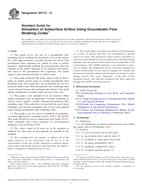Potrebujeme váš súhlas na využitie jednotlivých dát, aby sa vám okrem iného mohli ukazovať informácie týkajúce sa vašich záujmov. Súhlas udelíte kliknutím na tlačidlo „OK“.
ASTM D5875/D5875M-13
Standard Guide for Use of Cable-Tool Drilling and Sampling Methods for Geoenvironmental Exploration and Installation of Subsurface Water-Quality Monitoring Devices
Automaticky preložený názov:
Štandardné sprievodca pre použitie kábla-Tool Vŕtanie a odberu vzoriek pre Geoenvironmental prieskum a inštalácia podpovrchových vôd, kontroly kvality zariadenia
NORMA vydaná dňa 1.8.2013
Informácie o norme:
Označenie normy: ASTM D5875/D5875M-13
Poznámka: NEPLATNÁ
Dátum vydania normy: 1.8.2013
Kód tovaru: NS-32913
Počet strán: 8
Približná hmotnosť: 24 g (0.05 libier)
Krajina: Americká technická norma
Kategória: Technické normy ASTM
Kategórie - podobné normy:
Anotácia textu normy ASTM D5875/D5875M-13 :
Keywords:
cable-tool drilling, drilling method, geoenvironmental exploration, groundwater, vadose zone, ICS Number Code 13.060.10 (Water of natural resources)
Doplňujúce informácie
| Significance and Use | ||||||||||||||||
|
4.1 Cable-tool rigs (also referred to as churn rigs, water-well drilling rigs, spudders, or percussion rigs) are used in the oil fields and in the water-well industry. The Chinese developed the percussion method some 4000 years ago. 4.2 Cable-tool drilling and sampling methods may be used in support of geoenvironmental exploration and for installation of subsurface water-quality monitoring devices in both unconsolidated and consolidated materials. Cable-tool drilling and sampling may be selected over other methods based on its advantages, some of which are its high mobility, low water use, low operating cost, and low maintenance. Cable-tool drilling is the most widely available casing-advancement method that is restricted to the drilling of unconsolidated materials and softer rocks. 4.2.1 The application of cable-tool drilling and sampling to geoenvironmental exploration may involve sampling unconsolidated materials. Depth of drill holes may exceed 900 m [3000 ft] and may be limited by the length of cable attached to the bull reel. However, most drill holes for geoenvironmental exploration rarely are required to go that deep. Rates for cable-tool drilling and sampling can vary from a general average of as much as 7.5 to 9 m/h [25 to 30 ft/h] including setting 200 mm [8 in.] diameter casing to considerably less than that depending on the type(s) of material drilled, and the type and condition of the equipment and rig used. 4.2.2 The cable-tool rig may be used
to facilitate the installation of a subsurface water-quality
monitoring device(s) including in-situ testing devices. The
monitoring device(s) may be installed through the casing as the
casing is removed from the borehole. The sand line can be used to
raise, lower, or set in-situ testing device(s), or all of these. If
necessary, the casing may also be left in the borehole as part of
the device.
1.1 This guide covers cable-tool
drilling and sampling procedures used for geoenvironmental
exploration and installation of subsurface water-quality monitoring
devices.
1.2 Several sampling methods exist for obtaining samples from drill holes for geoenvironmental purposes and subsequent laboratory testing. Selection of a particular drilling procedure should be made on the basis of sample types needed and geohydrologic conditions observed at the study site. 1.3 Drilling procedures for geoenvironmental exploration often will involve safety planning, administration and documentation. This guide does not purport to specifically address exploration and site safety. 1.4 The values stated in either SI
units or inch-pound units are to be regarded separately as
standard. The values stated in each system may not be exact
equivalents; therefore, each system shall be used independently of
the other. Combining values from the two systems may result in
non-conformance with the standard.
1.5 This standard does not purport to address all of the safety concerns, if any, associated with its use. It is the responsibility of the user of this standard to establish appropriate safety and health practices and determine the applicability of regulatory limitations prior to use. 1.6 This guide offers an organized collection of information or a series of options and does not recommend a specific course of action. This document cannot replace education or experience and should be used in conjunction with professional judgment. Not all aspects of this guide may be applicable in all circumstances. This ASTM standard is not intended to represent or replace the standard of care by which the adequacy of a given professional service must be judged, nor should this document be applied without consideration of a project's many unique aspects. The word “Standard” in the title of this document means only that the document has been approved through the ASTM consensus process. |
||||||||||||||||
| 2. Referenced Documents | ||||||||||||||||
|
Podobné normy:
Historická
15.9.2008
Historická
1.4.2013
Historická
1.4.2013
Historická
1.7.2006
Historická
1.7.2006
Historická
1.8.2013



 ASTM D5611-94(2008)..
ASTM D5611-94(2008).. ASTM D5718-13
ASTM D5718-13 ASTM D5719-13
ASTM D5719-13 ASTM D5738-95(2006)..
ASTM D5738-95(2006).. ASTM D5754-95(2006)..
ASTM D5754-95(2006).. ASTM D5784/D5784M-13..
ASTM D5784/D5784M-13..
 Cookies
Cookies
